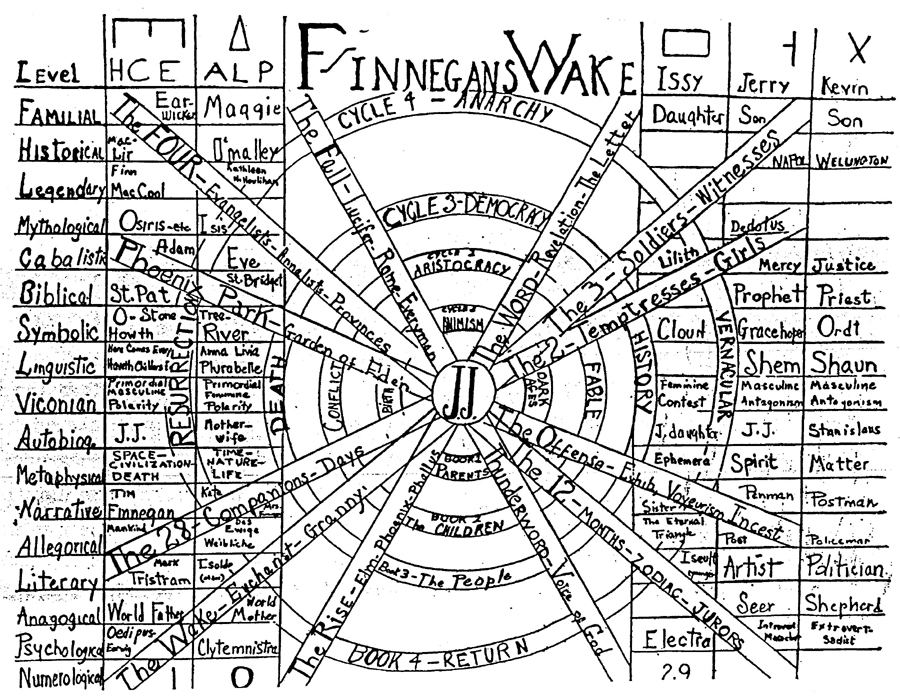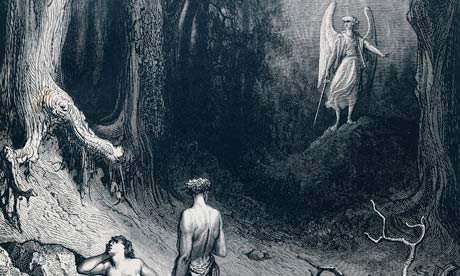Joyce was omnivorous. And as a result,
it is possible to trace practically anybody as his predecessors and
influences in the composition of Finnegans Wake. However,
there appear to be a handful of influences on Joyce that are writ
large, such as Bruno, Vico, The Egyptian Book of The Dead, and Lewis
Carroll. I will suggest that the influence of Blake also played a
major role (1).
Early in his career, Joyce gave a
series of lectures mapping the realist and imaginative currents in
English literature at the Università Popolare, Trieste (2). The twin
poles he furnished for this literary cartography were Defoe, and
Blake.
It is tempting to see in this dichotomy
a foreshadowing of Joyce's development here: progressively more and
more deeply imaginative and original treatment of more and more
extensive exploration of the details of everyday existence. In doing
so, by his own inner realist logic, when incorporating the conscious
and finally the unconscious mind, his methods would take a decidedly
imaginative direction. As Joyce extended his realist domain he
successively exhausted and shed each progressively more original (and
progressively darker) stylistic shell. First, exploring human drama
and incident (Dubliners and Portrait), he then directed
his scrupulous attention to human society, technics and conscious
human awareness (Ulysses), and finally (Finnegans Wake)
into a dim and blurry, yet paradoxically painstaking, comedy of myth,
history, the unconsciousness, sleep, and dreams. Yet even in
Finnegans Wake, Joyce's naturalism sought to build his
imaginative structure on what Blake called the “minute particulars”
of observation. I will argue that Blake's imaginative structures
provided models for certain aspects of Finnegans Wake.
However, at first glance there would
not appear to be a close relationship for Joyce with this Romantic and mystical poet he cited as his epitome of the imaginative pole. Joyce
was a lapsed Catholic and materialist, with an aesthetic orientation,
a realist in the technical sense, and a highly refined and subtly
distanced intelligence, with a nuanced and somewhat whimsically
earthy equivocating spirit that sought to simultaneously redeem and
embrace everyday life, and therefore built upon the commonplace the
“outward sign of an inward grace”.
Blake's orientation was primarily
spiritual, and was a devout, albeit highly unorthodox Protestant
Christian who fled from the ordinary, and urgently wished to redeem
human beings from the oppression of religion, law, excessive
rationality and sexual repression. Blake's mind had a decidedly
otherworldly cast. Blake's humor lacks most of the Joycean whimsy and
earthiness, and rather tends towards the choleric irony of the truly
earnest. Although a writer, Blake was also a practicing printer and
visual artist, whereas Joyce was neither.
Nonetheless both share a surprising
number of traits. Both were unafraid of obscurity and ambiguity.
Both attempted to describe nonrational states of consciousness. Both
believed in the primacy of art. Both were highly unconventional.
Both were largely self published, and marginalized. They were both interested in artistically totalizing universal experience. (3) And both
unwaveringly followed a personal path into territories largely
incomprehensible to their contemporaries.
Blake's major prophetic poems represent
an earlier venture to create a universal myth, and provide many
surprising thematic similarities to and anticipations of Joyce's
final work. We also know that Joyce was quite familiar with Blake's
poetry, and had read his unfinished major prophetic poem “The Four
Zoas”, as well. Of all of Blake's works, the “Four Zoas”seems
to bear an especially close structural affinity to Finnegans Wake,
and I will argue that there are significant parallels between Wake,
as well as other of Blake's work, such as “The
Marriage of Heaven and Hell.”
In Blake's “Four Zoas”, Albion,
Blake's Universal Man, and analog of the Kabbalah's Adam Kadmon(4), the
primal soul that contains all souls within it, and an anthropomorphic
representation of the universe, is shattered into partial aspects of
reduced consciousness, through a dream sequence of nine nights, and
reassembled into a spiritual and psychological whole. HCE in
Finnegans Wake shares a similar role as the universal being, a
Humpty Dumpty, that encompasses all, who has a great fall, and whose
consciousness lies in fragments and seeks reintegration. In both
cases the fragments take on independent existence as separate beings.
And in both cases, the original pure and undivided consciousness has
passed through a form of “forgetting”, where it no longer
recognizes these beings as offshoots of itself.
In both works, time
is treated in an unconventional way. Events in Blake's treatment are
atemporal everpresent archetypes, and in a sense constitute
consciousness states that exist outside of time. (Blake uses the
term “eternity”, not in the sense of everlastingness, but rather
as a term for atemproality.) In Finnegans Wake, time is
cyclical and therefore eternal, and also overlaid, so that the past
and future are contemporaneous “forriver”.
For Blake the divided human soul is
represented as a fourfold entity, the four Zoas, which represent
creativity/imagination/spirit, reason/law/judgement, emotion/love,
and body/desire/need. HCE, Joyce's Divided Man lies spread out and
“dud” stretching to the four corners of the earth, the four
“dimmansions” of space-time--between his bedposts which come
alive as the Four Annalists/Evangelists, each the patron of one of
the four Viconian Ages. These follow the archtetype of fourfold
forms, “three and one different or special”: north is the compass
point to which the needle points; time is the one dimension of the
four that is consumed; John is the Evangelist who seeks to put a more
spiritual/philosphic gloss on things; the Ricorso is the Age of
Chaos, the “a-wake-ening” of all forms at once; Urthona, the Zoa
that represents creativity/imagination/spirit, and thereby
incorporates all the various energies that need to be reassembled.(5)
To the waking mind polar opposites are
subject to the dissective hygene of Aristotelian logic, so that the
inconvenient other can be disowned. But in a dream world, or seen
from a non-rational level of consciousness, opposites become what
Blake called “contrarities”, and are “equally true.” Blake
tends to approach this as a drama in “eternity”, splitting off
and recombining to reach resolution; since this is “eternal” (in
the Blakean sense) these polar opposites coexist. Joyce's
pun-language has the luxury of combining two meanings in the same
word with true simultaneity, and therefore takes the form of an
epiphany, or frozen continuous moment, rather than a drama (albeit
understood in a special timeless way).
However, both authors have linguistic
strategies for expressing simultaneous contrarities. Both use forms
of humor. The Joycean weapon is the pun. Joyce very frequently uses
them in such a way that they suggest not merely different meanings,
but opposite meanings, rendering the reader gobsmacked, and even
wondering, for example, “if life is worth leaving.” Although
Blake's language is certainly obscure, he does not make such
extensive use of puns. However he frequently makes use of irony, and
deliberately uses certain words in a very special sense. For
example, although very spiritually oriented, Blake's always uses the
term “religious” in a negative sense, and treats“chastity”
and “virginity” as opposites. In “The Marriage of Heaven and
Hell”, he actually reverses the roles of Hell and Heaven,
Satan and God; the proverbs in its “Proverbs of Hell” section are
what Blake believes. There
is one particular aspect of Finnegans Wake that
particularily follows the ironic construct of “The Marriage of
Heaven and Hell”.
The
brothers dual/duel in Finnegans Wake represent the relation of the disinherited other, Shem, to the heir, Shaun. In
the “Marriage of Heaven and Hell” Satan's account is that he
really is Jesus, and that he “built heaven from what he stole from
the abyss”. Taking the ironist view of “Marriage” opens a
particular reading of the twins. A exoteric reading of Finnegans Wake
would see Shem (Lucifer) as despicable merely. The ironist view
suggests, rather, Shem is all of the scary needful bits of HCE that
he cannot acknowlege, and is the gatekeeper of art, spirit and
enlightenment; Shaun all that his repressive consciousness can accept
and approve. In Finnegans Wake the Universal Man cannot live without the integration
of these two contrarities.
Footnotes
I have dispensed with references to quotes from Finnegans Wake, and other quotes that should be familiar.--ES
(1)
Whose Blake Did Joyce Know and What Difference Does It Make?Anita Gandolfo
James Joyce Quarterly
Vol. 15, No. 3 (Spring, 1978), pp. 215-221
JAMES JOYCE AND PALE BLAKE
By Elaine Mingus (need to find)
(2)
Joyce's lecture on Blake, was part of the series announced as "Verismo ed idealismo nella letteratura inglese (Daniele De Foe–William Blake)" (that is, "Realism and Idealism in English Literature") and presented at the Università Popolare, Trieste. The first lecture on Defoe took place on 9 February 1912 (see John McCourt, The Years of Bloom [Dublin: Lilliput Press, 2000], pp. 178–179). This may be the faircopy from which Joyce presented the lecture.
http://library.buffalo.edu/pl/collections/jamesjoyce/catalog/viia2ai.htm
(3)
I must create a system or be enslaved by another mans--Blake
http://www.brainyquote.com/quotes/quotes/w/williambla165311.html#RkItG2B8Z9V2XyAb.99
(4)
In the religious writings of
Kabbalah, Adam Kadmon is a phrase meaning "Primal Man". The oldest rabbinical source for the term "Adam ha-Ḳadmoni" is Num. R. x., where Adam is styled, not as usually, "Ha-Rishon" (the first), "Ha-Kadmoni" (the original).
It is said that Adam Ḳadmon had rays of light projecting from his eyes. In
Lurianic Kabbalah, Adam Ḳadmon acquired an exalted status equivalent to
Purushain the
Upanishads, denoting an anthropomorphic concept of the universe itself. In this variant of mythopoetic
cosmogenesis and
anthropogenesis, the "Adam Soul" is described as the primeval soul that contained all human souls.
anthropomorphic concept of the universe itself. In this variant of mythopoetic
cosmogenesis and
anthropogenesis, the "Adam Soul" is described as the primeval soul that contained all human souls
http://en.wikipedia.org/wiki/Adam_Kadmon
(5)
In “The Four Zoas”, the quarrel between the Urizon and Urthona reminds one of the brother duel. However, in the “Four Zoas”, Urthona is not treated ironically, but heroically. The Zoa representing the mind usurps the the place of the Zoa that represents the spirit instead of confining itself to those things that are appropriate for rational consciousness, resulting in the fragmentation and disintegration of all aspects of being. )















